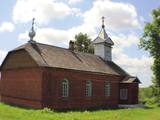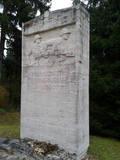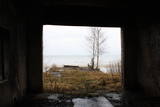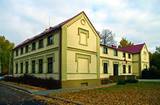| Нo | Название | Описание |
|---|---|---|
|
Моленная Борисовской старообрядческой общины построена
в период с 1911 по 1921 год. В отличие от других окрестных
моленных она построена из кирпича и расположена на холме.
Колокол этого храма привезен по заказу из Санкт-Петербурга и
отличается своим мягким звуком.
|
||
|
Крестьянское хозяйство «Пиладжи» находится в Дурбском крае, Дурбской волости. Основной вид деятельности хозяйства – выращивание зерновых. Дополнительно в хозяйстве занимаются разведением крупного рогатого скота, выращиванием рассады цветов и овощей. |
||
|
Предприятие по разведению породистых овец ООО «Мукайтас» – семейное предприятие, основанное в 2005 году. Миссия предприятия – предлагать мясопроизводственным стадам племенной материал, который дает быстрорастущих ягнят с отличными мясными качествами. В хозяйстве разводят овец породы Oxforddown. В хозяйстве можно приобрести породистых ярочек разного возраста, племенных овец и баранов, пряжу, изделия из шерсти, обработанные шкуры овец, овец для стравливания травы, баранину и разные мясные изделия. |
||
|
Маршрут походит для любого путешественника, желающего насладиться красотой природы и средой Северного Курземе, где, кроме водных туристов, нет других людей. Ирбе за короткое время стала популярной рекой благодаря красивым береговым ландшафтам. Мест для ночлега здесь нет, поэтому необходимо взять с собой палатку и заночевать на какой-нибудь стоянке для водных туристов. Информация о маршруте от Latvijas Lauku forums |
||
|
Убаговский чертов камень. Это культовое место находится в
южной стороне хутора Убаговас, у дороги (130 м на север, северо-
западнее от сельского кладбища). Местное население рассказывает,
что здесь появляется привидение, если человек идет один, и
заманивает его в лес. Высота камня 1,6 м, поверхность гладкая.
|
||
|
Хозяйка «Русского подворья» (Vene talu) готовит вкусные блюда русской национальной кухни по рецептам своей прабабушки. Гостей знакомят с традициями и предлагают обильный стол для дегустации. Также есть чайный салон, проводятся мастер-классы по приготовлению блюд русской кухни. |
||
|
The campsite is located 77 km from Riga, surrounded by beautiful forest and sea. The range of offers is wide - beach volleyball court, basketball court, windsurfing, table tennis and more. There are tent sites as well as double or quadruple camping houses. There are facilities for people with reduced mobility. The campsite is open from 1 May until 31 October. Large WC and shower room (shared). |
||
|
In mid-summer, the farm features the beautiful blooms of rapeseed and flax. A special facility for pressing rapeseed and flax seed oil is on site. You can watch the oil pressing process and purchase some of the resulting oil.
|
||
|
В 3 км к югу от центра Юркалне, у старой (гравийной) дороги Лиепая – Юркалне находится место, где располагалась бывшая Феликсбергская трехлетняя мореходная школа (1871 - 1902 г.). Так как от здания ничего не сохранилось, ее место обозначено сколоченной из дуба лодкой и двумя деревянными столбами, на которых вырезаны древние знаки рыбацкой собственности. |
||
|
Находится на обочине шоссе Р 100 (недалеко от шоссе А 8, направление на Озолниеки и Елгаву). Памятник посвящен стрелкам 6-го Рижского пехотного полка, павшим и пропавшим без вести в боях с бермонтовцами 17-го ноября 1919-го года возле бывшей основной школы Скуяс. Памятник (автор Николай Войт, автор барельефа Мартиньш Шмалцс, консультант Карлис Зале) был открыт 24-го октября 1937-го года. Его отреставрировали в 2009-м году. |
||
|
Хозяйство Uibo предлагает посетителям традиционные блюда эстонской кухни, приготовленные из свежей свинины с минимальным количеством консервантов и добавок. |
||
|
Строительство храма велось в период с 1801 – 1804 годы. В центре алтарной части церкви находится картина второй половины 19 века “Христос на кресте”. Колокол отлит в 1895 году, а орган построен в 1914 году. Перед входом в церковь возвышается памятник павшим во время Первой мировой войны и в боях за независимость Латвии (скульптор К.Зале, архитектор А. Бирзниекс), который был открыт в 1930 году. Совсем недавно завершены работы по реставрации фасада и интерьера церкви. |
||
|
This reserve dates back to Lake Ancilus, which was one of the original elements of what is now the Baltic Sea. The lake’s ancient shores feature wetlands, forests and flora which are all protected by the reserve.
|
||
|
Šo sakrālo celtni uzskata par vecāko Zemgales baznīcu, kas joprojām pilda savu pamatfunkciju. Tās celtniecību uzsāka 1567. g. un pēc nopostīšanas atjaunoja 1614. g. Pēc poļu - zviedru un Ziemeļu kara to atkārtoti atjaunoja 1815. g. Dievnamu var apskatīt arī no iekšpuses. |
||
|
В 1242 году на этом месте немецкий орден построил каменный замок, от которого до сегодняшнего времени сохранились только отдельные фрагменты стен и свод подвала, в котором по предварительной договоренности можно заказать дегустацию вина местного производства. В более поздние времена здесь находился замок герцога Курземе, который был разрушен во время Северной войны (1701 год). В результате проекта реконструкции парка созданы деревянные мостки, информационные стенды, построена беседка и фонтан. В парке возведены отдельные скульптуры и их группы (22 скульптуры, автор Ливия Разевска). |
||
|
Хозяин создал специальный комплекс курсов и процедур, которые посвящены здоровому образу жизни. Обучение для групп, массажи, лекции, практические занятия и т.п. |
||
|
Находится на 67 км шоссе Рига – Лиепая (A9). Любимое место путешественников для обеда. Латышская кухня: Щавелевый суп, маринованная селедка с творогом, «Деревенская трапеза» (картофель, яйцо, копчено мясо, маринованный огурец), свиные котлеты, бефстроганов по-курземски, тушеная кислая капуста с охотничьими колбасками, ячменная каша с мясом, крем из черного хлеба, хлебный суп с взбитыми сливкам. |
||
|
This part of the Forest Trail gives an opportunity to see Setomaa or “the Land of Setos” which is inhabited by Setos – an ethnographic group with specific ancient traditions and a unique language dialect. Forest Trail hikers can visit the traditional Setos homestead and enjoy Setos cuisine. The forests of the region are especially charming in early autumn, when the ground is coloured lilac by the blooming heather. There is a good chance to pick wild mushrooms and berries. One of the most beautiful sections of this trail in Setomaa leads along the River Piusa, where the river is surrounded by sandstone outcrops. You will also visit the Piusa caves. The tour will end in Värska resort – with its sanatorium and SPA, which use the strengths of local nature: mineral water and lake mud. Värska mineral water is well known in Estonia and elsewhere. |
||
|
Окинув сегодняшним взором, кажется невероятным, что какие-то двадцать лет тому назад на побережье располагались специально построенные сооружения с мощнейшими прожекторами, которые в темное время суток по специальным рельсам выталкивались на платформах с целью освещения близлежащей морской акватории и пляжа в поисках потенциальных нарушителей границы. От упомянутого объекта сохранились только развалины сооружений и прилегающей платформы, над которыми здорово потрудились волны моря.
|
||
|
In 1888, the building, provided for a doctor’s needs, was donated by Baron Alexander Alexei von Pistohlkors to the parish of Pēterupe Lutheran Church. Along with the building, Baron Pistohlkors also donated 6 hectares of land and 10 000 roubles for the doctor’s use. Arvēds von Engelhards became the first medical doctor in Pēterupe. In 1890, the first pharmacy was opened in one room of the clinic, serving people from a wide area; it remained in the building until 1895. This outpatient clinic was the very first stone building in Saulkrasti, the first health authority in a wide area, as well as the first pharmacy. Through its entire lifetime, the house was maintained from voluntary donations – at first by Alexander Alexei von Pistohlkors, then by churchgoers of Pēterupe Parish – therefore by the money of the villagers. |
||

























